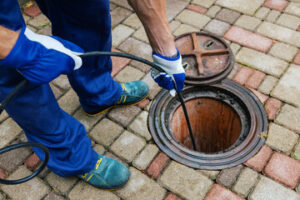Sewer Cleaning are available to help homeowners with their plumbing needs. There are various types of cleaning methods, including hydro-jetting, snaking, step cleaning, and pressurized carbon dioxide. These methods are used to clear clogged pipes and restore sewer lines. However, before choosing a cleaning service, it’s important to know the basics.
Hydro-jetting is an effective way to clear clogs in your sewer lines. It can cut through just about anything, including grease clinging to the pipe walls, tree roots, and other debris. It is an effective way to clean your pipes thoroughly, without the cost or hassle of a full-line repair.
Sewer line clogs are common, and they can also be a source of contaminated water. Hydro-jetting is a popular choice for sewer cleaning, and it can help you avoid recurring clogs and costly pipe replacements. However, it’s not the only option for sewer cleaning. There are other methods as well, including snaking or using a force-ball plunger.
While hydro-jetting does require a high-pressure water source, it can clean a sewer system efficiently. Tree roots, for example, can clog up a drain and cause overflows. Some estimate that 23,000 to 75,000 sanitary sewer overflows occur every year in the United States. Tree roots are the leading cause of sewer line breakages, and hydro-jetting can break up and dislodge tree roots before they cause damage.
Snaking is one of the oldest methods of clearing clogs from drains and sewer lines. It is also relatively gentle and is a great option for older or fragile pipes. This method works by rotating a steel cable shaped like a snake inside a clogged pipe until it clears the clog. It can be an effective temporary solution to certain problems, but it is not recommended for more stubborn blockages.
However, it can also damage older or damaged pipes. If you don’t have the necessary equipment, it is best to call a professional plumber who is trained in sewer cleaning. The professional plumber will first inspect the pipes to avoid any damage. Next, the plumber will use an auger. An auger is a steel cable with a cork-screw-like coil on one end. The auger coil is inserted into the sewer pipe to clear away obstructions.
Hydro-jetting is another method for sewer line cleaning that is more thorough. While snaking is effective at clearing minor clogs, this method does not clean the pipes thoroughly. If you do decide to use this method, call a professional plumbing company for advice. They will be able to determine which method will be best for your system.
Using a cleaning solution containing baking soda and vinegar is an effective method to remove grease and another buildup from sewer lines. The solution creates foamy bubbles, which scrape away the grease. Unlike water, grease is sticky and can trap other types of debris. Even when you don’t dump much food or water down the drain, grease can build up in sewer lines. It’s a quick and easy method to use whenever you notice that your sewer line is dirty.
When a sewer line is clogged, it’s crucial to clean it. Fortunately, there are several methods for cleaning it. The first method is mechanical cleaning, which involves manual cutting or scraping to clear large blocks of solid waste. The second method, called hydraulic cleaning, involves the use of high-pressure water and a nozzle to clear the blockage. These methods are effective at removing clogs, which can lead to stagnant water and costly repairs.
When cleaning sewer lines, it is important to keep in mind that the presence of bloodborne pathogens and other contaminants is common. These agents may be present in wastewater, blood, or saliva. They can also be present in cuts, abrasions, and other openings. These entry points can cause a variety of diseases. In order to prevent these infections, it’s important to make sure you’re washing your hands properly and wearing gloves whenever possible.
Pressurized carbon dioxide for sewer cleaning can be used to treat a variety of sewer blockages. This gas can be used in a number of ways, including powering generators or combined heat and power plants. Its use can help reduce the demand for fossil fuels, but it can also negatively impact the durability of some materials, including the lining of sewer pipes. It can also cause microbial and biogenic sulfide corrosion, which can eventually lead to the collapse of structures.
Different flow conditions can lead to different transformation rates of pollutants in wastewater. This could affect the number of greenhouse gases produced. Flow-rate data from the main sewer revealed that the accumulation rate of CO2 gradually increased. The highest accumulation rate occurred at the confluence segment. The generation rate then stabilized throughout the sewer.
The sewer system is filled with a variety of hazardous gases that can be dangerous to human health. Hydrogen sulfide, for example, is extremely toxic to the human body and can cause organ damage or even death. Ammonia, which is widely used in cleaning chemicals, is also a contaminant. It has a strong odor and can irritate the throat and nose. Additionally, it can cause a fire hazard in large quantities.
